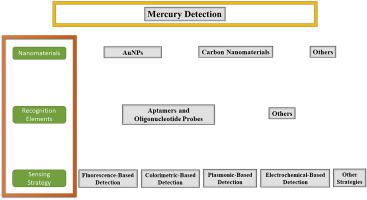Talanta ( IF 6.1 ) Pub Date : 2020-07-24 , DOI: 10.1016/j.talanta.2020.121437 Samet Şahin 1 , Mustafa Oguzhan Caglayan 1 , Zafer Üstündağ 2

|
Heavy metal ion pollution is a severe problem in environmental protection and especially in human health due to their bioaccumulation in organisms. Mercury (II) (Hg2+), even at low concentrations, can lead to DNA damage and give permanent harm to the central nervous system by easily passing through biological membranes. Therefore, sensitive detection and monitoring of Hg2+ is of particular interest with significant specificity. In this review, aptamer-based strategies in combination with nanostructures as well as several other strategies to solve addressed problems in sensor development for Hg2+ are discussed in detail. In particular, the analytical performance of different aptamer and oligonucleotide-based strategies using different signal improvement approaches based on nanoparticles were compared within each strategy and in between. Although quite a number of the suggested methodologies analyzed in this review fulfills the standard requirements, further development is still needed on real sample analysis and analytical performance parameters.
中文翻译:

综述了基于适体和寡核苷酸生物传感器的基于纳米结构的汞(II)检测和监测。
重金属离子污染由于其在生物体内的生物蓄积,在环境保护尤其是人类健康中是一个严重的问题。汞(II)(Hg 2+)即使浓度很低,也容易通过生物膜而导致DNA损伤并对中枢神经系统造成永久性伤害。因此,对Hg 2+的灵敏检测和监测特别感兴趣,而且具有很高的特异性。在这篇综述中,结合适体的策略与纳米结构以及其他几种解决Hg 2+传感器开发中已解决问题的策略详细讨论。特别地,在每种策略内以及两者之间,比较了使用基于纳米颗粒的不同信号改善方法的不同适体和基于寡核苷酸的策略的分析性能。尽管本评价中分析的许多建议方法均满足标准要求,但仍需要对实际样品分析和分析性能参数进行进一步开发。


























 京公网安备 11010802027423号
京公网安备 11010802027423号